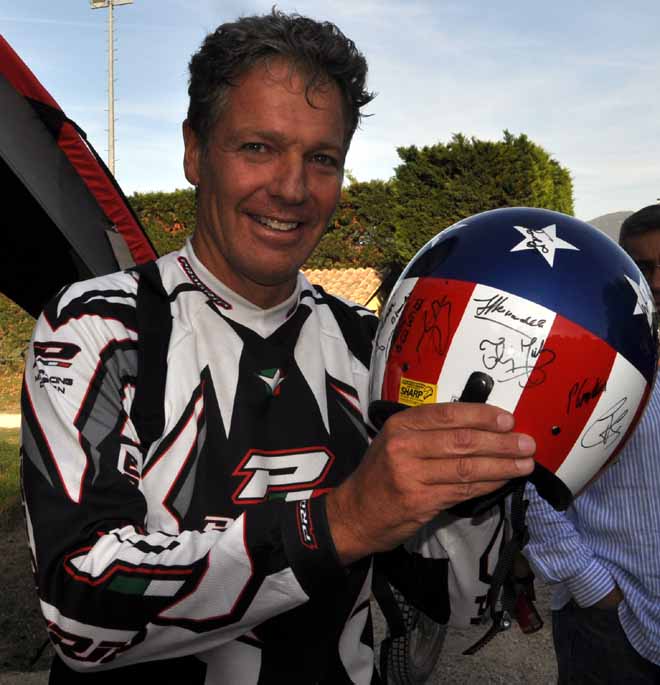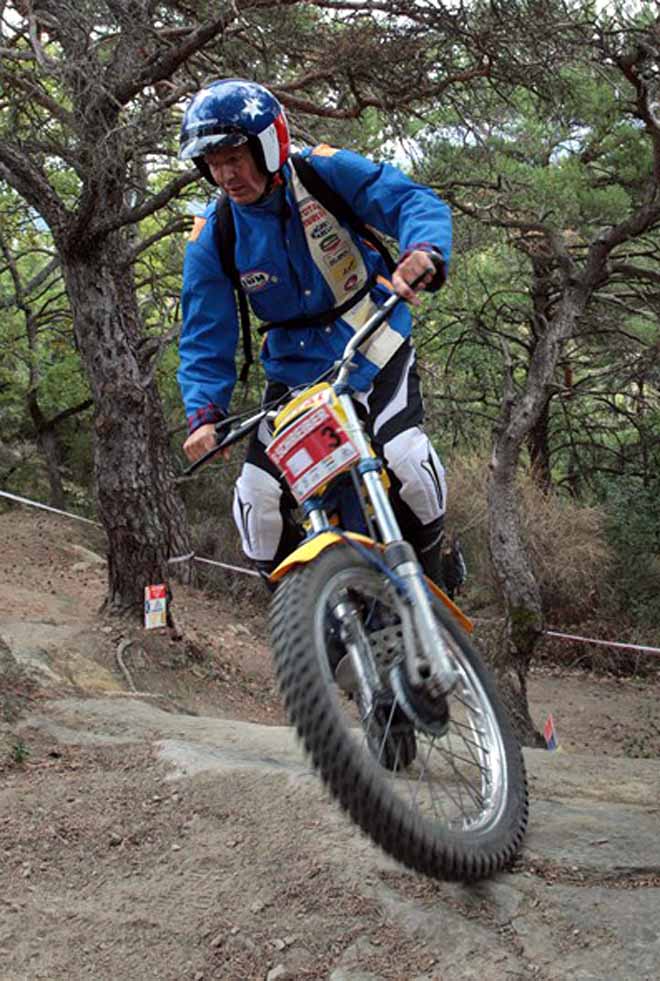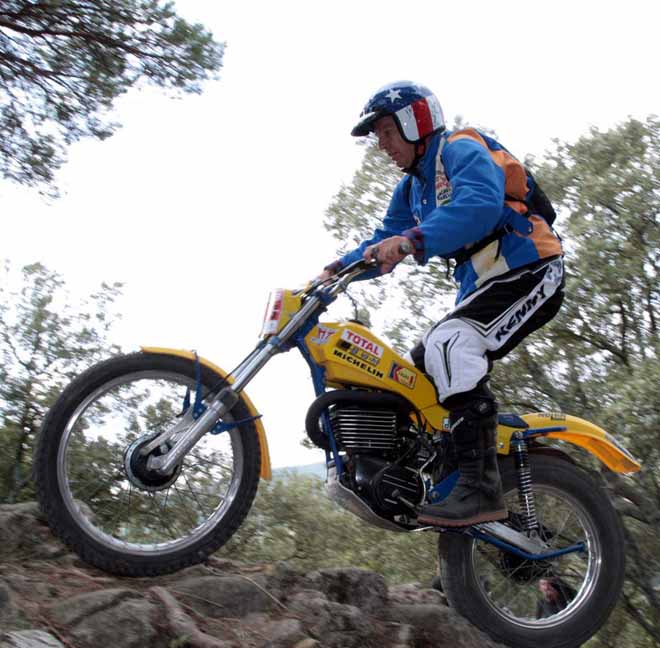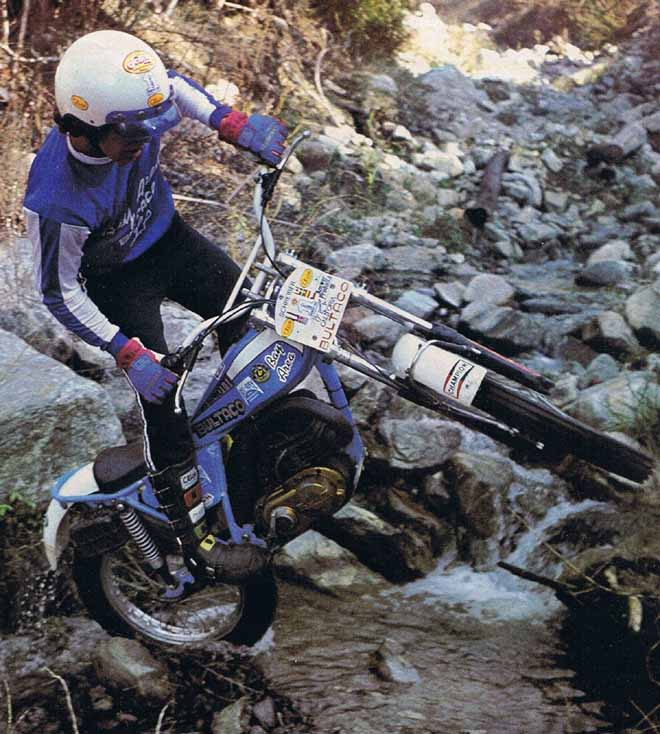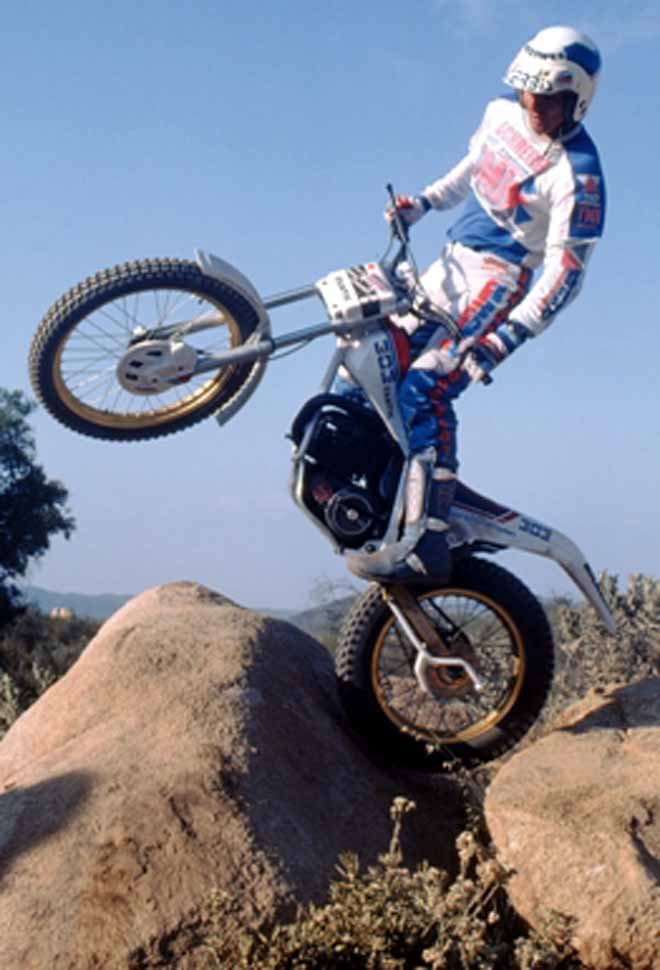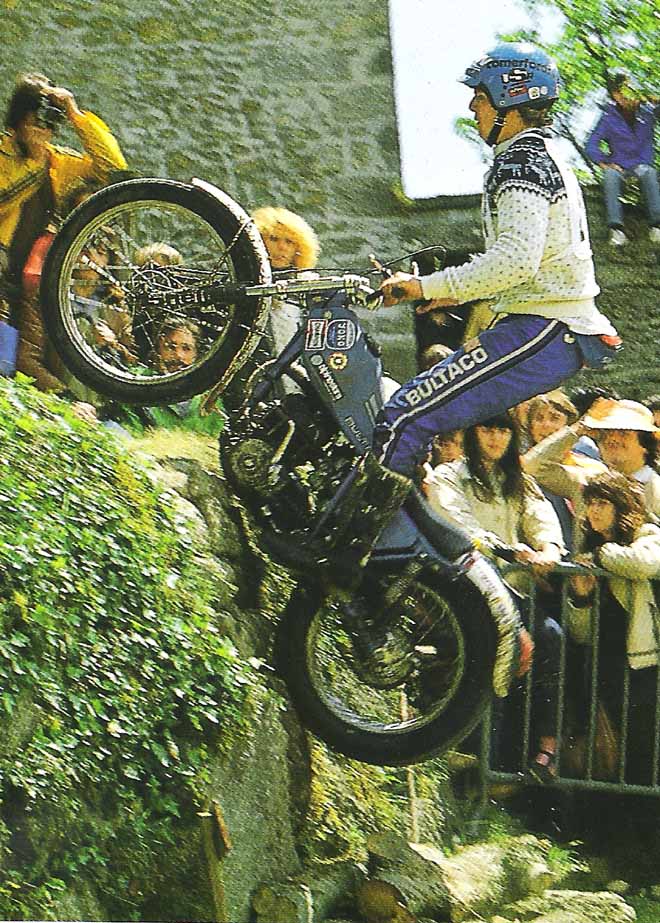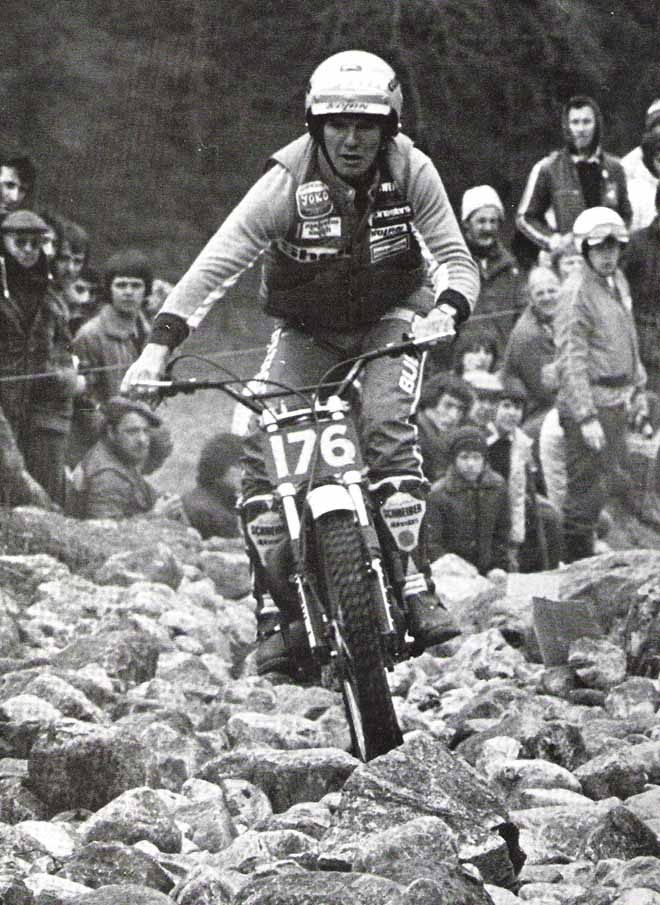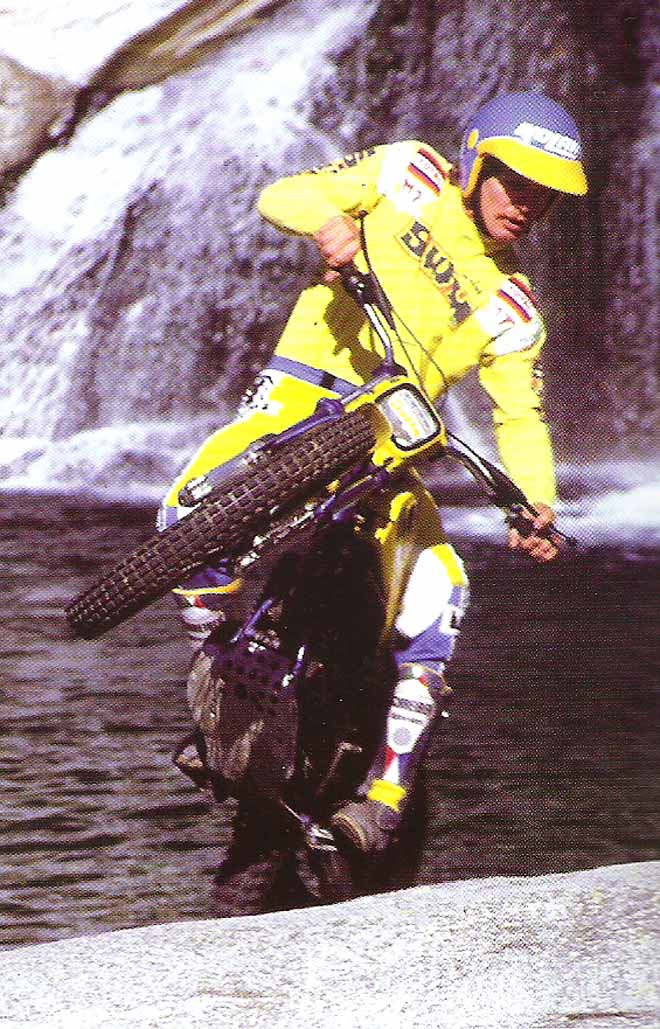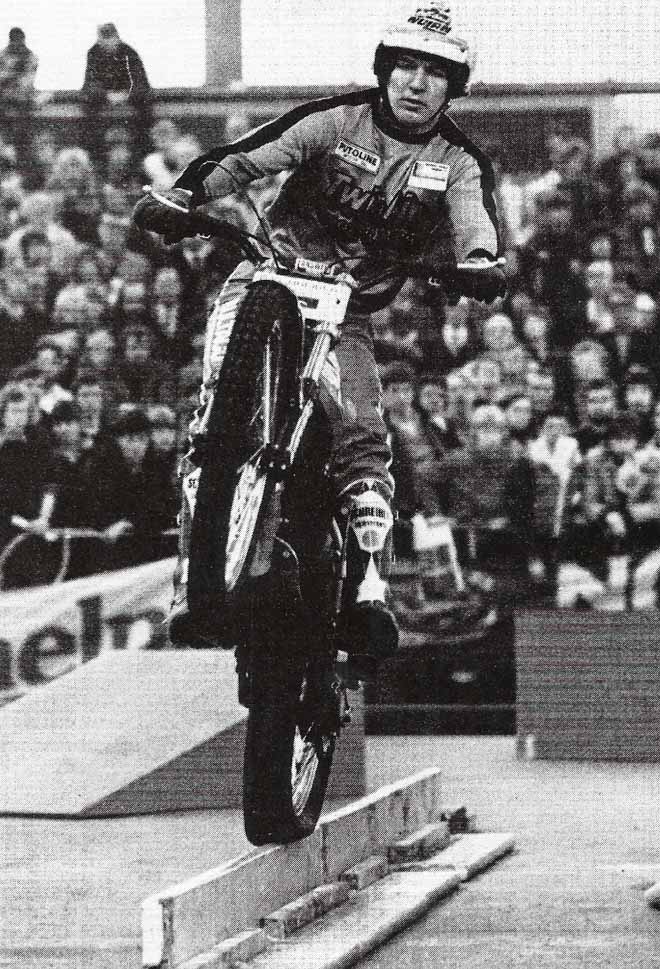BERNIE SCHREIBER, world champion
Bernie Schreiber was born at Los Angeles on the 20, January 1959. He was the first (and only) US rider to become world trials champion, Scottish Six Days winner and also winner of every important event in the eighties. In addition to his world title, Schreiber also won the U.S. National Trials Championships in 1978, 1982, 1983 and 1987.
He started his world career in 1977, when Finn Yrio Vesterinen was the champion. He finished twice on the podium, runner-up in Germany and a final seventh place in the championship riding with Bultaco. Not bad for an eighteen year old rookie!
In the days when Spanish manufactures such as Bultaco and Montesa dominated the scene, riders never used the clutch or did “bunny hops” in the sections. It was Bernie, who started a new style of riding, with the front wheel in the air, a finger on the clutch, and rear wheel bunny hops. Schreiber developed a hard-charging style that proved to be evolutionary during a time of many changes, even in the way trials bikes were designed.
In the following year (1978) he won 4 GPs: France, Spain, USA and Italy. But Vesterinen and Martin Lampkin gathered more points, even though they achieved fewer victories than him. His final third place came as a prelude to the world title, of which he clinched in 1979, after a strong recovery and finishing poorly in the first three rounds of the season.
When Bultaco filed bankruptcy in 1980, he changed to Italjet, the Italian manufacture during that season. Only at the end of the championship he found a good feeling with his bike and accomplished 4 wins in a row, finishing the championship in second place, behind Swedish rider Ulf Karlsson. In 1981 he faced many mechanical and development challenges which proved to make a difficult season. No victories and an overall sixth place in the championship.
The SWM factory still believed in his ability to become world champion, as Giles Burgat in 1981. In the next three years, he found his way barred by a world-beating Belgian, Eddy Lejeune. He was twice vice-champion in 1982 and 1983, then in third place in 1984.
Kicked back and relaxed in 1985, due to SWM’s crisis and no mono-shock bike, he then acquired a contract with Yamaha in 1986 and finished seventh place in the championship. In his 10th and final year, he rode with Fantic to win his final US national championship and he only had a few appearances in the world championship that year.
Living in France he started to work as European Sales Manager for MS Racing mountain bikes and eventually Alpinestars. From 1990 he officially retired from official trials events.
At the “Ventoux Trial Classic” held at Malaucene on the 15th and 16th of October 2011, we crossed him again, riding a 1984 SWM jumbo. When the competition has terminated he was talking with Vesterinen’s wife, but was willing to talk with us shortly.
Welcome back Bernie…what have you been doing these past years?
“For the past 12 years, I was very busy working with Tissot watches in Switzerland, and that didn’t leave me much spare time. Two years ago, I was invited for my 30 years anniversary (1979-2009) to a vintage Trial in Madrid, Spain, where I rode a Bultaco alongside Manel Soler. Fun! I terminated my profession and wonderful experience at Tissot in 2010 and took a career break. Now I’m in a transition period and searching my next challenge! Trust me; I will not exclude the motorcycling industry.”
Have you kept up with the trials world championship? What do you think of the low number of riders participating in trials today? Is it necessary to change the rules?
“I follow the top results, seen a few indoors on TV, and I am very impressed what Bou, Raga and the other riders are doing on a modern trials bike. They should all be competing in the X-GAMES with those skills. In my opinion, it’s necessary to change something to make the sport more popular in practice and audience. Trials could have several high profile disciplines and live together as family, and this can be seen in other sports. Take skiing for example: there is downhill, giant slalom, special slalom etc… so why can’t Trials develop new guidelines with new rules which could coexist together for everyone?”
And what about the Federation? Will they agree with it?
“Don’t wait for the International Federation to develop our sport. That’s not their job. Their role is to enhance cooperation with the national federations, ensure supervision of the sport, rules, public affairs, safety and protection of the environment. Trials needs a revolution, leadership, someone with clear and concrete ideas, and the Federation would follow this new project, approved by riders and manufactures. The Trials fans, sport and enthusiasts are more alive than ever. This weekend they had to limit the riders to 340 after a request for nearly 500! All the marketing tools are in place to make the greatest two wheel sport ever… with over 100 years of history popular, and I mean popular.”
---------------------------------------------------------------------------------------
Bernie Schreiber nasce a Los Angeles il 20 gennaio 1959. E’ il primo statunitense (e unico) campione del mondo, vincitore della Sei giorni di Scozia e di tutto quello che d’importante c’era negli anni 80. Oltre al titolo mondiale, Bernie e' campione nazionale nel 1978, 1982, 1983 e 1987
Si affaccia alla scena mondiale nel 1977, dove spadroneggiava il finlandese Yrio Veesterinen. Due volte sul podio, con un secondo posto in Germania ed un settimo posto finale in campionato. Guida una Bultaco. Niente male come esordio per un diciottenne!
Tempi in cui le moto spagnole Bultaco, Montesa facevano da padrone. Si guidava senza usare le frizione e senza gli “spostamenti”. Proprio lui da’ il via a nuove tecniche di guida, che risultano rivoluzionarie per quei tempi. La ruota anteriore impennata, il dito sulla frizione, il sollevare la ruota posteriore. Corre a cavallo di un’epoca di grossi cambiamenti anche nel modo di progettare le moto da trial.
Nell’anno successivo (il 78) si aggiudica 4 gran premi: di Francia, Spagna, USA ed Italia. Ma Vesterinen e Martin Lampkin arrivano prima di lui, pur non battendolo nel numero di vittorie. Il terzo posto e’ preludio al titolo cha arriva nel 1979, dopo una lunga rimonta a causa di una partenza non troppo brillante.
Poi il fallimento della Bultaco, con il passaggio all’italiana Italjet a meta’ della stagione. Solo nel finale riesce a trovare il giusto feeling per infilare 4 successi consecutivi e terminare il campionato secondo dietro allo svedese Ulf Karlsson.
Nel 1981 diversi problemi meccanici e di sviluppo della moto lo costringono ad un ruolo di comprimario. Nessuna vittoria e sesto posto finale. Ma la SWM crede ancora nel suo potenziale e gli affida la moto che si appena laureata campione del mondo con Burgat.
Nei tre anni successivi, si trova la strada sbarrata da uno strepitoso belga Eddy Lejeune. E’ due volte vice-campione nel 1982 ed 1983, quindi terzo nel 1984.
Pausa riflessiva nel 1985, con la crisi della SWM e nessuna moto mono-ammortizzatore, poi contratto con la Yamaha nel 1986, con settimo posto finale. Ancora un passaggio di marca nel 1987, ora Fantic. Quarto titolo nazionale, ma solo qualche apparizione nel mondiale.
Poi sparisce, va a vivere in Francia ed inizia un’attivita’ di Direttore Commerciale per la MS Racing mountain bikes e per la Alpinestars. Non lo si vede piu’ sulla moto in uscite ufficiali dal 1990.
Nella “Ventoux Trial Classic” disputata a Malaucene il 15 e 16 ottobre scorso, eccolo in sella ad una SWM Jumbo del 1984. Finita la gara e’ impegnato a parlare con la moglie di Vesterinen. Molto gentilmente ci concede una brevissima intervista.
Bentornato Bernie, ma dove sei stato in tutti questi anni, niente moto?
“Negli ultimi 12 annu sono stato molto impegnato con il lavoro, per la Tissot orologi, non avevo un minuto di tempo. Sono stato invitato ad un’altra gara di moto d’epoca in Spagna, a Madrid 2 anni fa, in occasione dei 30 anni dal mio titolo(1979-2009). Ho corso con una Bultaco insieme a Manel Soler. E' stato divertente! Ho terminato la mia professione e positiva esperienza con la Tissot nel 2010 e mi sono preso un anno sabbatico. Ora sono in questo periodo di transizione, alla ricerca di qualche nuova sfida! Non escludo una nuova avventura in campo motociclistico.”
Hai seguito l’evoluzione del trial mondiale? Cosa pensi del fatto che ci sono sempre meno piloti nella massima categoria? Si deve rivedere il regolamento?
“Leggo i risultati, ho visto qulche indoor alla TV e sono veramente impressionato da cosa Bou, Raga e altri piloti riescono a fare con le moto moderne. Con quei numeri, potrebbero tutti competere negli X-GAMES. Secondo me e' necessario fare dei cambiamenti per rendere lo sport piu' popolare per chi lo pratica e per chi lo guarda. Credo che il Trial deve poter avere tante diverse specialita’ che possono convivere tutte insieme. Prendi lo sci: c’e’ la discesa, lo slalom, il gigante, ecc... Perche’ non si puo’ anche fare cosi’ nel Trial? Con regole simili, potrebbero convivere il no-stop, il tradizionale, le moto d’epoca ed altro.”
Ma pensi che la Federazione accetterebbe?
“Non aspettiamo che la Federazione Internazionale sviluppi il nostro sport. Non e' il loro compito. Il loro ruolo e' di garantire una cooperazione con le federazioni nazionali, presidendo i regolamenti, i rapporti con il pubblico, la sicurezza e la protezione dell'ambiente. Al Trial serve una rivoluzione, una guida, qualcuno con idee chiare e concrete. Poi la Federazione sarebbe costretta a seguire quello che puo’ essere un nuovo progetto, appoggiato da Case e piloti. Il trial e’ piu’ che vivo. In questo evento hanno dovuto limitare i partecipanti a 340, a fronte di una richiesta di ben 500! Ci sono tutti i presupposti commerciali per fare diventare il nostro sport il piu' grande fra quelli delle due ruote. In fondo ci sono piu' di 100 anni di popolarita', di vera popolarita'. ”
